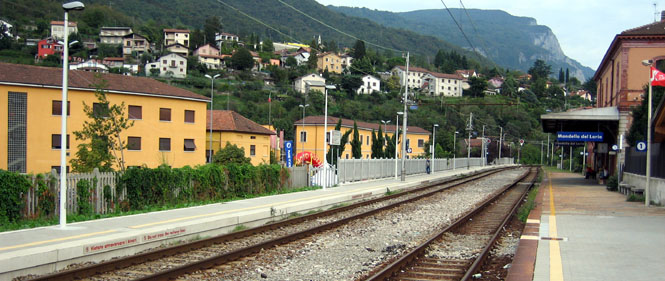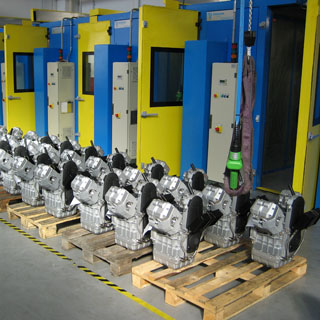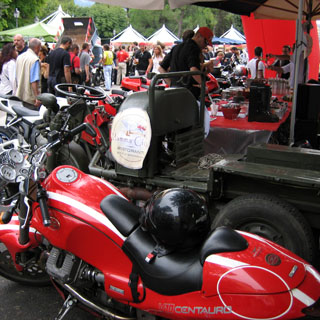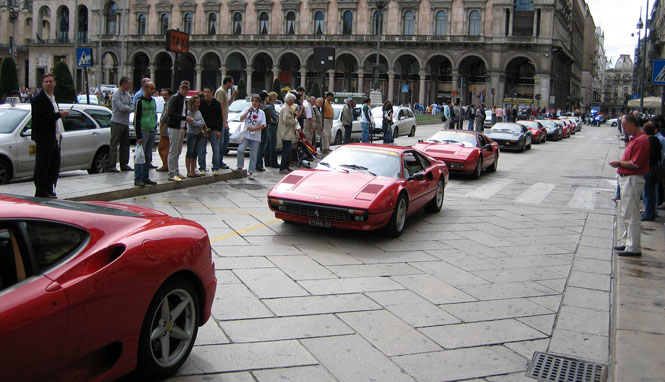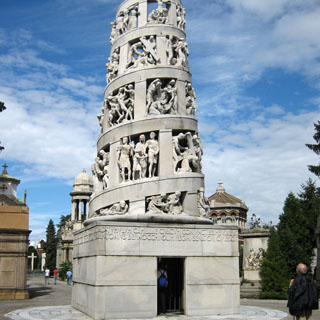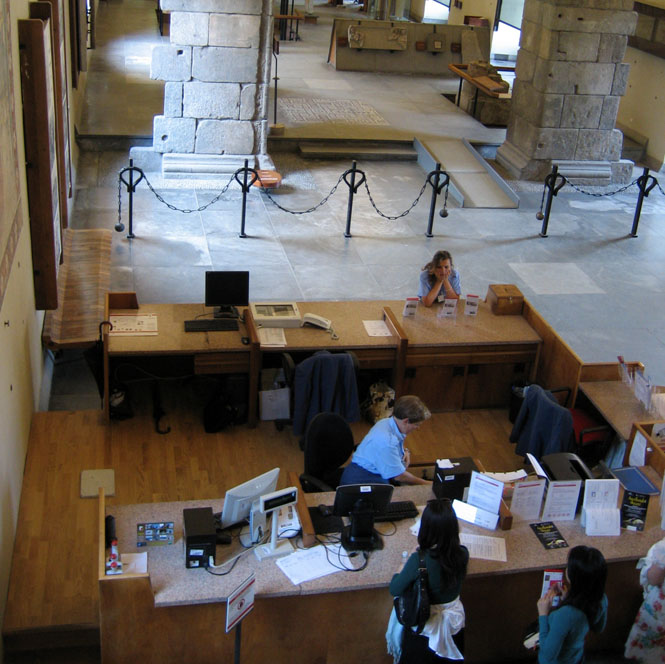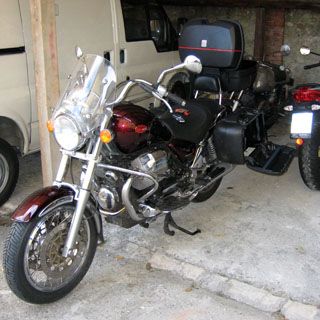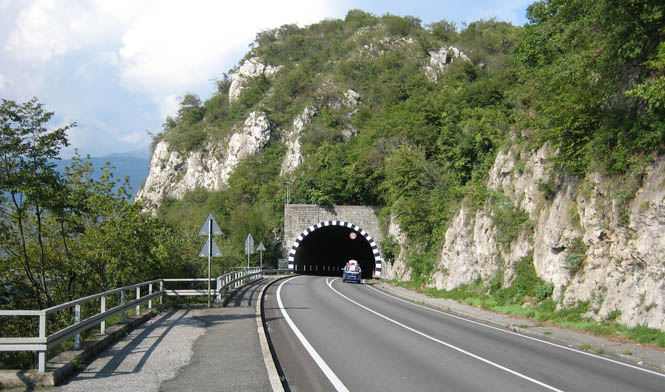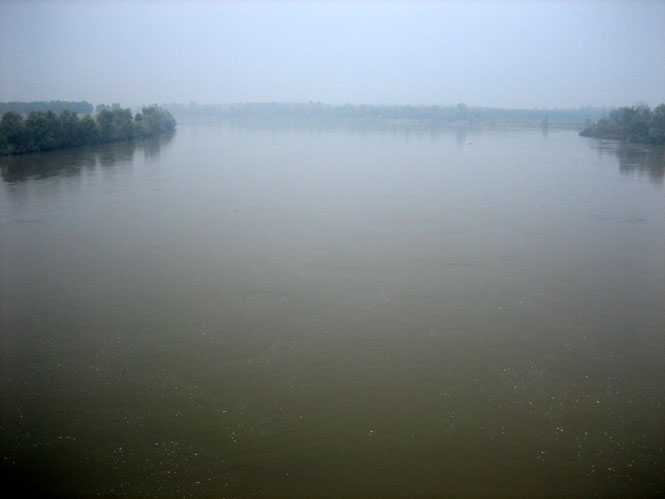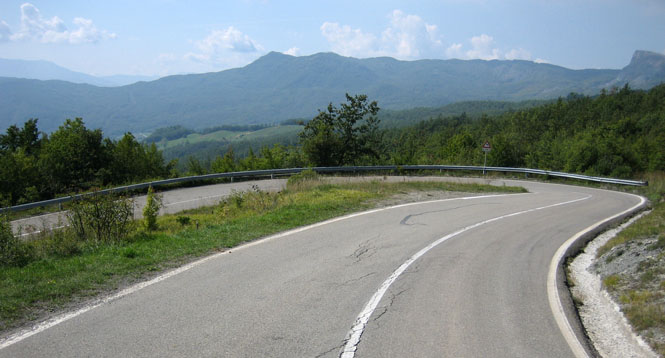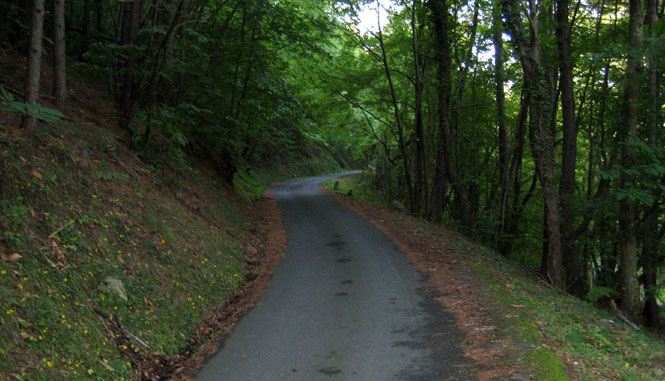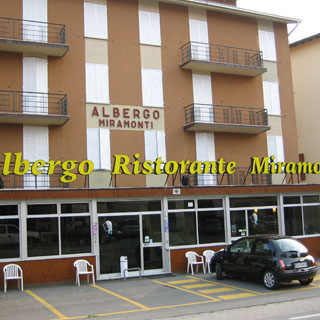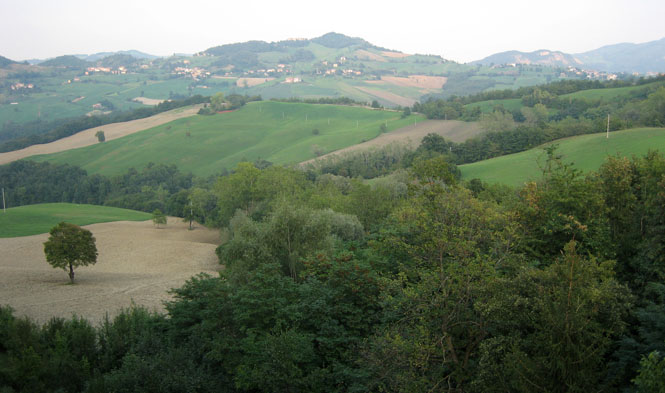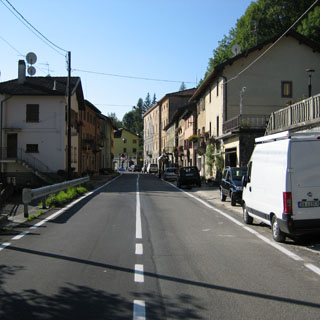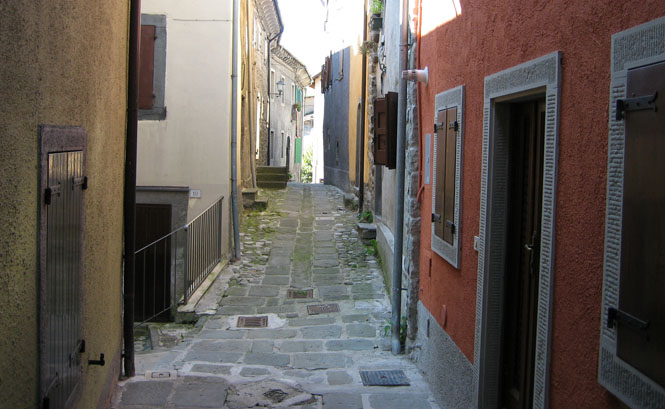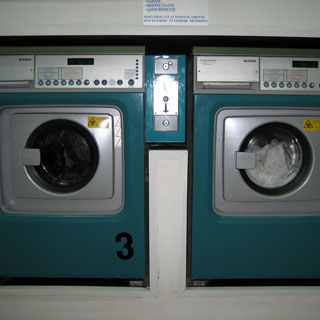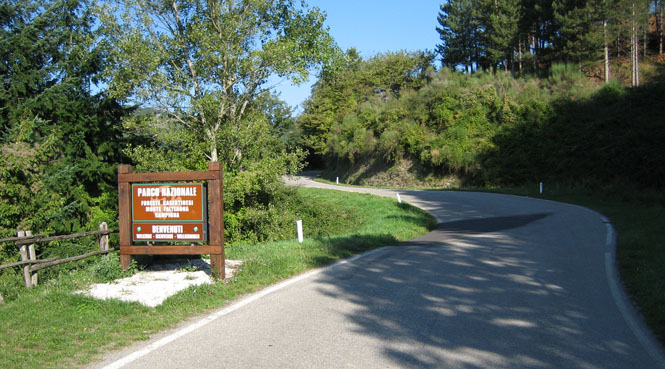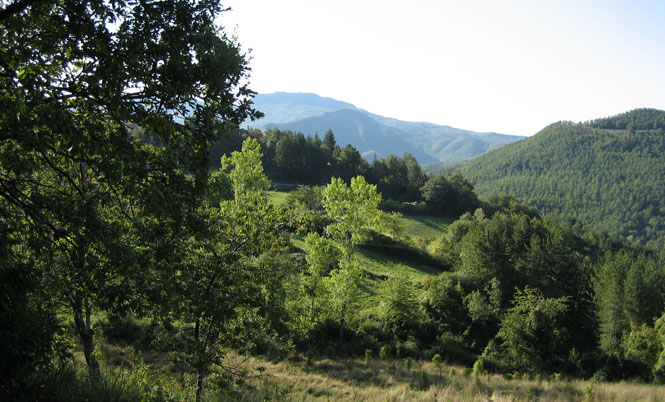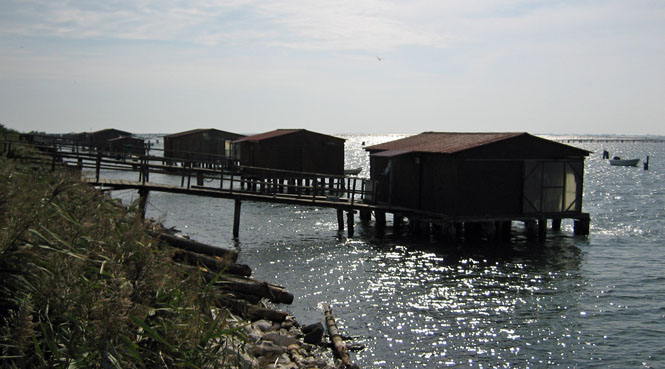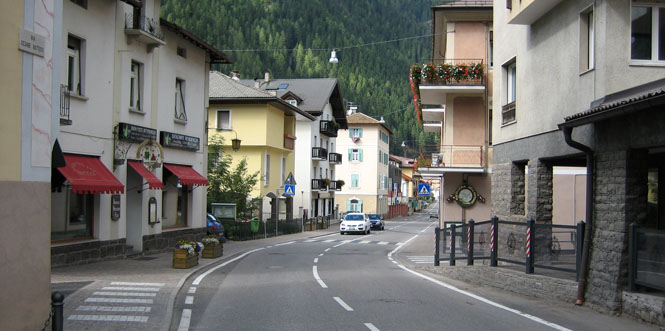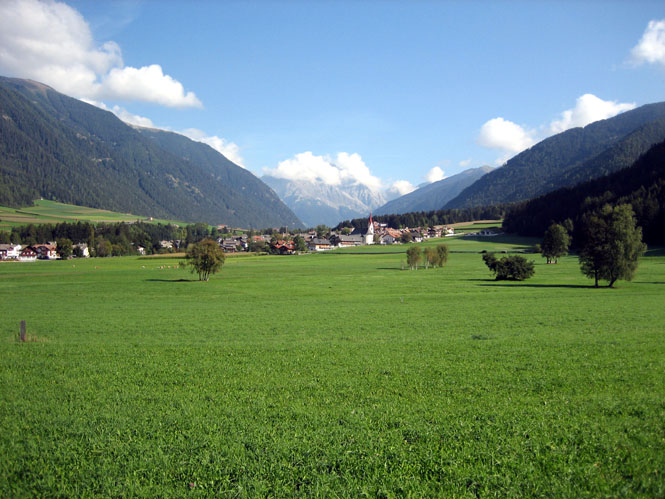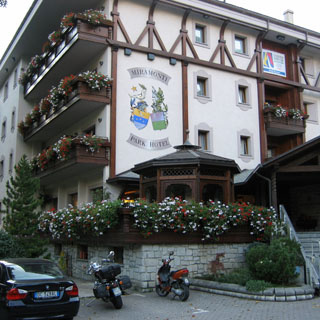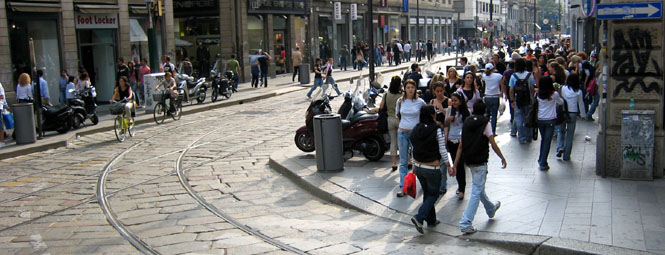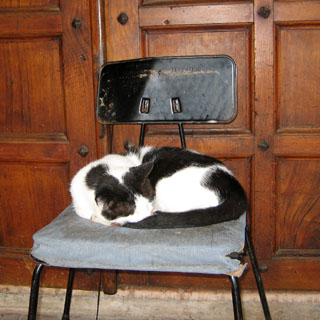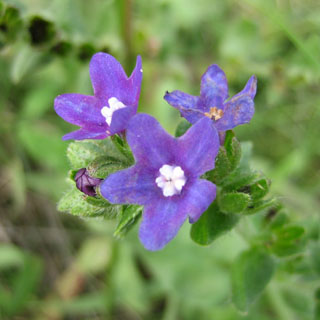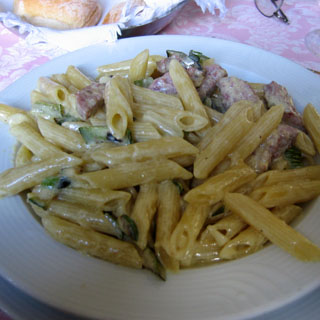
 September,
2006
September,
2006
Sunday |
Monday |
Tuesday |
Wednesday |
Thursday |
Friday |
Saturday |
10 September |
11 |
12 |
13 |
14
|
15
|
16
|
17
|
18
|
19 |
20 |
21 |
22 |
23 |
24 |
25 |
26 |
27 |
28 |
29 |
30 |
1
|
2 |
3 |
4 |
5 |
6 |
7 |
 Europe Motorcycle Trip #1
Europe Motorcycle Trip #1
Why Italy?
There are not many places that will rent Moto Guzzis. A very good one is in New Zealand, and in Italy, Agostini is another.

Obviously, if I'd only extend my list of acceptable motorcycles beyond this rather obscure brand, I'd have any number of popular models to choose from, and in most any country. Perhaps so. But, for this trip, I wanted to be on a Guzzi. I'm comfortable with them.
In any case, Mandello del Lario has been the home of Moto Guzzi since 1921, and I have long wanted to ride there. As it turned out, there was another very good reason to make this trip.
When I was sorting which time would make the most sense, the last couple of weeks in September seemed the most likely (the peak tourist month of August was always out of the question). Only then did I realize that this was the 85th anniversary of Moto Guzzi and that the factory was planning a major event (GMG-2006: Giornate Mondiali Guzzi). Thousands of people would be there.
But, thousands of people also meant that I needn't bother trying to find a room in Mandello during the event. And, too, rentals would not be available during that time. So the choices were narrowed, and everything now fell nicely into place.
I'd stay in Milan the first two nights (but still attend at least part of the celebrations in Mandello) then spend Monday in Mandello before picking up the motorcycle Tuesday morning (after the celebrations) and beginning the ride. Eleven days on the road is easily done, and is just a little less than the two week solo trips that I have often made. There was no need to push things--particularly when riding someplace entirely new to me--and, this was the same schedule that worked so well in New Zealand.

A couple of notes about this report:
- Few of the village names meant much to me, and as I often turned off on roads that looked interesting--without knowing where they were going--I would end the day without a really clear idea of which towns I had been through, and which roads I took (look at my trace on the map, and you'll understand). I think I've sorted that out (as explained, later), but it remains that I am not able to fix exactly some of the towns that I've taken pictures of. I think I'm right, but I wouldn't be surprised to find that I'm wrong. So, if I've labeled a town with the wrong name, you'll understand.
- Some cities have both an Italian name and a name which is used by others. Sometimes just the spelling is different, and sometimes the two names seemingly have nothing in common (Livorno=Leghorn, Firenze=Florence). I'll use the local names (except when I don't).
 Kansas
Kansas
My planning for the trip amounted to buying all the regional Michelin maps of the country as well as several guide books (I never intended to take the guide books with me, but I did take the maps). Before I left, I came to know the northern roads--or at least had a general sense of them--as well as where the mountains are and where they're not. Beyond those first nights in Milan and Mandello (and the last two nights of the trip) I would make no plans for any of the days; that is, the days that I'd be riding. From that standpoint, this trip was done pretty much the same as my US trips--just ride someplace, and then ride someplace else. I'd figure it out along the way.
What was packed was determined by what I would later have to re-pack into the saddle bags. Not much. The riding suit, boots and helmet took most of the space (the helmet always stayed with me in the carryon bag).
The first leg of the flight was south to Houston--not exactly cutting the distance to Milan.
 Texas
Texas
And, in Houston I waited.
And, waited some more. It seems there was some sort of problem and the needed part was not available at the airport. As it happened, though, I didn't need to worry about making connections (in Newark), as this same airplane would be the one to continue to Milan--different flight number, different crew, but the same plane.
Sitting in a dark tube where time has no meaning...
Lombardia
The arrival and passage through Malpensa airport was surprisingly quick. No forms to fill out, barely a line for immigration, and nothing at all for customs. I only had to wait for my bag to show (few things are as visible as an optic yellow Ortlieb pack) and then head out to find the train.
The Malpensa Express is a dedicated train between the airport and the Cadorna train station in central Milan. Just inside the door to each car is a large area for luggage; each car has two seating levels. The word "express" is not exactly appropriate as it does make several stops along the way.
The principal reason that I made reservations at the Hotel Palazzo delle Stelline was that it would be within walking distance of the Cadorna Station. I was trying to make this whole operation as easy as possible.
When I stepped onto the street, I really was not sure which way to even start walking. Street names didn't seem to be too obvious (they never were), and anyway, these starfish intersections didn't resemble what I was expecting from the map (which, in any case, I did not have with me). None of this was a problem.
That's because I had a handheld Garmin GPS, which made navigating the streets of Milan a breeze. With a bag over each shoulder, I pulled out the GPS, clicked on the waypoint for the hotel, and started walking.
That's the hotel, at the end of this street.

It's not a particularly impressive place from the outside--I didn't even see the entrance at first even though the GPS said I was there.
But, I would find this to be common. If you were to look beyond the doors of some very ordinary buildings in the city, you'd often see spectacular gardens in a central courtyard within. The walls facing these inner courtyards were often much more impressive than those facing the outside world.
The hotel began as a monastery in the 15th century, and had more recently been a girls school of some sort before being reborn as a conference center and hotel. That building in the back? That's the church of Santa Maria delle Grazie, best known for being the home of Leonardo da Vinci's "The Last Supper." This is the view from the balcony outside my room.
There's not much more to say about the room except to say that I didn't spend much time in it. It's worth noting that when I stayed at this same hotel the night before flying back to Kansas my room would be twice as large as this one.
I didn't have time to rest; I needed to take the train to Mandello del Lario. This was more traveling than probably makes sense (considering that it was now Saturday noon and I had been up since early Friday).
I left the bags and walked back to Cadorna Station for the metro ride to the Milano Centrale Station. It wasn't difficult sorting out how to purchase a ticket. That first one (to Centrale) was purchased from a person at a ticket booth, but after that I used only the machines. I would get on and off 14 trains in total, so I did get the hang of the way things generally worked. And, they worked pretty well. A single ticket on the Metro is just 1 Euro.
The Pirelli building was one of the early post-war office buildings to go up, and it still looks good.
I can't say as much for the Centrale station, however. Big, imposing and intimidating is probably what they had in mind, and they certainly achieved all that. This is one of the largest train stations in all of Europe.

The ticket machines worked well. Tell it where you want to go, and after a long pause (the first time I thought the system computer must have frozen) you're offered several choices. It seemed to all cost the same, and the ticket was only for the destination--not a specific time--but, I found that the schedule shown on these machines was accurate. The price to Mandello del Lario? Less than 6 Euros.
You had better be sure of your train, as there are lots to choose from, and they're not identified. Any schedule and platform information that was electronic (real time) was trustworthy (in this case platform 10 is what I wanted); Anything posted, was not. I had already learned (back at Malpensa airport) that simply buying a ticket is not enough. You must also validate it before getting on the train. That means inserting it into a machine to have the date and time stamped on it.
Now climbing the hills north of Monza towards Lecco.
Busted!
Only rarely did I ever see a conductor checking for validated tickets, but it did happen. The conductor also checked that a person holding a 2nd class ticket wasn't sitting in the 1st class car. In this case, that's exactly what happened. I don't know how much more these (American) people had to pay for their mistake, but it was not trivial. I had purchased a 1st class ticket as it was only 1 Euro more (I'm not sure that it gave any more comfort, but it's nice to think you're traveling 1st class, if only by what the ticket says).
Travel note: If you're going to Mandello del Lario, you first must go to Lecco (below). This is useful to know as there are other options for getting to Lecco from Milan than just from Centrale. At Lecco, you'll get off one train, and wait for the next. There are a few direct trains to Mandello del Lario, but I was never on one.
Mandello del Lario is only ten miles from Lecco (along the shoreline of Lake Como), so it's not a very long ride. That's the Moto Guzzi factory to the left (the yellow/orange buildings), and the main reason I was here, today.
Looking over the railing next to the tracks.
I have never, ever, seen so many Moto Guzzis in one place. In fact, I doubt that all the Guzzis I have seen in my lifetime add up to this. And, this photograph is only a small fraction. The whole town was packed with them. Actual traffic jams of motorcycles (rare in itself) and they were all Moto Guzzis. It sounded great.




The Moto Guzzi factory museum is deservedly famous. They've been making motorcycles here since 1921 (the one below was the first), and the museum seems to have at least one copy of every model made.
Another nice thing is that these motorcycles have generally not been restored to original and immaculate condition. While they're clean and in good condition, they look like they've been recently used and could easily be fired up and run some more.
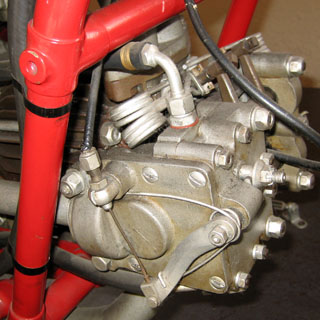



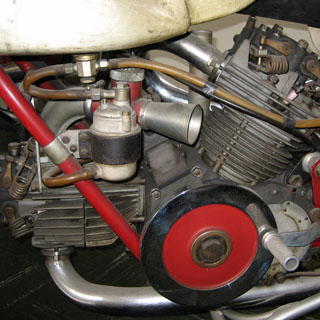





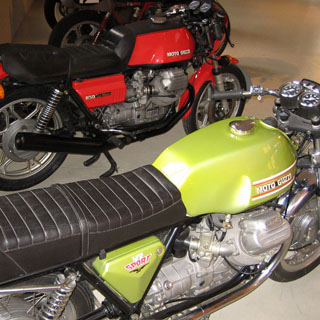

Guzzi was the first motorcycle company to build their own full-scale wind tunnel to help them design their racing fairings.

Once through the factory and the gift shop, I walked down towards the water (Lake Como). This was my first chance to see a small Italian town and I loved it. In time I'd come to find plenty of streets that were much more narrow than this one.
Lafranconi Silenziatori - the other Mandello del Lario Company.
It seemed that just about every shop and every ristorante had a Moto Guzzi in the window. I am always expecting that nobody I meet on my trips will have heard of Guzzi, so it was especially amazing to see the level of support in this town. Just about everybody had a Guzzi shirt on. Of course, they do build them here...
I don't know how you could improve on this.
The town park had far more motorcycles than were even at the factory. That Magni Guzzi in the photograph (below) would normally be the center of attention at any other motorcycle event, but here it was just one more rare and exotic machine.

Dear Daniel, sorry for being so late in replying but I find myself at the end of each day without knowing where the time has gone. The man with the black jacket is Mario- He is the owner of Ristorante Al Verde in Mandello that many Guzzi lovers know as it is the place where many go to eat. The bike is owned by him and Roberto Patrignani (a journalist quite famous who writes about motorbikes on italian magazines) and has been mounted and prepared by Bruno Scola a quite well known mechanic of the Italian Guzzi world (you may had met him while you were here as actually he is working in our workshop). Love, Alis
GMG-2006 was spread over several days and had quite a few events that I would have loved to have seen (including a parade of many of the historic models), but my visit was only for part of the day. Time enough to walk through everything, but not long enough to linger. I caught the 7:00 train back to Lecco, then to Milan, then the Metro to Cardona and then walked back to the hotel. Starting with breakfast in Kansas, it had been a very long day.
I had all day, Sunday, to just knock around Milan. So, after getting up too late to see what sort of breakfast my hotel provided, I started out.
There was no possibility of getting lost, so I just kept turning down any street that looked interesting--the same concept that I'd be using in a couple of days on the motorcycle.
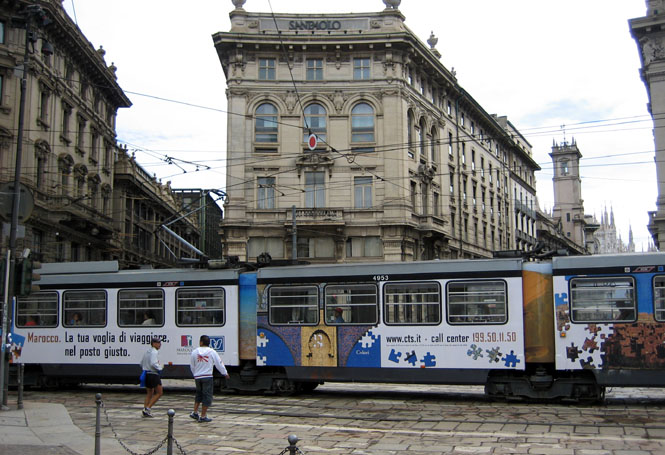
I first heard the sound of V-12 engines running up to redline before I saw the Ferraris. Lots and lots of them. Much of the cathedral plaza (piazza del duomo) was taken over by them, being the apparent start of some sort of organized rally. Eventually, they were led away under police escort. The lead cars were orderly and sedate, but those in the back were anything but. Typically, they'd slow to a crawl to create a little space between them and the car in front, and then they'd stand on it for short bursts of speed.
Off the same plaza is the galleria. Basically, it's the original shopping mall, but that hardly does it justice. This is the most spectacular shopping mall I have ever seen.
The cathedral of Milan is one of the largest in the world. What is especially impressive on the outside is the large number of statues. Every post, every ledge, every spire, has a different statue mounted on it.

The line to go inside was too long for me, so I joined the much shorter line to walk up the spiral stairs to the roof top.
One of the stranger places that I have ever been. The whole time, I was thinking of what it must have taken to build this thing. It's almost incomprehensible. Just bringing up one of the roof slabs would be trouble enough, let alone bringing up one of the many statues. Actually, just walking up carrying nothing at all was enough to tire out most of us.
The view looking north (Milan is flat, but the mountains are not too far away). Notice the three statues in the foreground. Now think about putting them there.
I wasn't paying much attention to where I was going, and was not at all sure what this large building was. Turned out to be part of Milan's cemetery and mausoleum.

Without question, this was the most unusual cemetery I'd ever been to. It was like walking in a reduced-scale city, except the buildings were not meant for the living.
All the buildings you see are mausoleums. Most are open, and have altars inside.

The most elaborate family and individual mausoleums I have ever seen. It's as if there has been a long running competition for the largest and most ornate. Eventually, though, I began to see it differently. It's actually a large sculpture exhibit, all with a single theme: death, and all that death means.
This one had me stumped. It's pretty clear that the person being honored had something to do with aviation. That part I can see. But, the pile of snakes partially coiled around the propeller? I assume that that's Mercury holding the propeller up, but then I have no evidence for that. The grieving angel in the background is not connected with the snakes, but she does seem to add another element to the piece.
The Sforza family ruled the Duchy of Milan for a hundred years, or so, starting around 1450 (the name means "The Force" which probably gives some insight to how things were). It was Duke Lodovico Sforza who commissioned "The Last Supper."
Original construction for Castello Sforzesco started in the 1300's, but the Sforza's took it over and turned it into their castle. It is immense to look at, today, and you can only imagine its impact in 1450. Today it houses a number of different museums.
Ticket sellers.
Michelangelo's last sculpture, the Rondanini Pietà; it was not finished before he died--1564.
Back at the church of Santa Maria delle Grazie. It requires pre-booking to be able to see "The Last Supper" (which gives you a limited time to see it under strict environmental conditions) which I did not do. No matter, the rest was open, and allowed photographs.
Fortunately, the building survived the bombings of WW2, largely intact.
Monday afternoon I again took the train to Mandello del Lario, but this time I would stay the night.
Lake Como.
Most of the crowds were gone. That's Mamma Ciccia's to the right (the rose colored building). You can see the ristorante, but the B&B and other buildings are behind. It's an easy walk from the train station down the street to the old part of town along the lake.
I could not have asked for a more perfect arrangement. That's Silvia, below, who is hardly your expected Mamma Ciccia. There are not many B&B's that have paintings on their walls that are a thousand years old.
Mamma Ciccia Ristorante
and Bed and Breakfast

But then, not many B&B's have a vintage Moto Guzzi in their courtyard, either.
Notice that open window in my room...
...this is the view.
I include this picture only to give you some idea of the sort of streets that I saw in several small towns of this size. That door to the left? That's a garage door. I watched the owner pull out in the morning, and drive away. He's clearly done it more than a few times.
The park was mostly empty of Guzzis, but there were still a number of folks hanging around. This gentleman (Berto is his name) was said to make the best cappuccinos to be found, and I wouldn't disagree. He's been at the job for many years.
Harry had ridden from Germany, and needed to replace his warped front brake disk. I gave him a hand (not that he needed it) as this is the same model of Guzzi that I own. This California II has about the same miles on it as mine (though he's done a Le Mans conversion to the engine) and it was interesting to go over the various issues that we both have seen. Our conversation entailed lots of hand motions, and mechanical drawings in the air.
...as Harry may eventually read this, I won't again bring up our discussion of why he should be using his front brake lever (which he doesn't touch) even though the brakes are integrated and how that would probably address the warping problem of the overworked front disk when you only use the rear brake pedal on steep mountain passes...

Moto Guzzi sponsors a racing team of boats.
Looking back towards the old part of Mandello del Lario. That church you see in the center? The B&B is next to it.

Eliza, the happy winner of the drawing for a new Moto Guzzi Norge. They were also staying at the B&B.
Tuesday morning, and it's time to go riding.
Duilio Agostini Moto Guzzi has long had a high reputation world-wide as a supplier of Guzzi parts and Guzzi accessories, serving people who aren't so lucky as to have a dealership near them. And, for the last few years they've been renting Guzzis, as well. I would not be in Italy were it not for them.
From my first contact with Alis, through the final fine-print paperwork, the whole process could not have been easier.
I'm afraid I've caught her looking much more bureaucratic (copying something from my passport and trying to figure out what a customer wants) than she normally is, but I have no doubt that this is a busy place.

And, here it is--the same color as I had several months back in New Zealand. The rear GIVI trunk was larger than I had then, so I'd have no trouble at all finding space for everything. That shorty windshield gave me pause, but it worked just fine. The larger ones do have a problem with buffeting--something that didn't happen with this one. The engine ran perfectly the entire time, and I didn't have a single problem with the motorcycle.
Where to, now?
Eventually, I wanted to aim for the west coast, but I didn't want to begin the trip by running through any congestion (what's the fun of that?). So, I turned right, and ran up the coast of Lake Como.

I stopped near Sondrio to get my bearings (and to make sure I was still on the right road).
Narrow roads and steep hills--this would be a constant of the trip. More unusual is the secure railing along this road (it's a very long way straight down to the stream below).
Always, when you look around you'll see a bell tower.
I would always double and triple check the pumps. In the US, the green pumps are almost always for diesel. Not so, here. Generally, there were two grades of diesel and two grades of gasoline--and not always paired together. None of the pumps I came across took standard bank cards (as virtually all pumps do in the US). But, they would take bills--but not give change. But, most of the time a person would come out to pump the gas for me (or at least make the offer, as I'd rather do it myself) so payment was easy enough.
Tunnels. Lots of tunnels. Long ones, too. Miles long. Frankly, I do not like riding in dimly lit, curving, narrow tunnels that are poorly ventilated.
Nearing the city of Brescia, I knew soon enough that I needed to find a way out before I got completely mired in rush-hour traffic. It did occur to me that when riding on roads like this (below) I could just as easily be near any large central-states city in the United States. There must be some sort of universal school of civic architecture for urban sprawl.
This is more like it (near Pontegatello). No traffic, and only the occasional farm buildings. None of the roads were marked, but I had a sense of which way to head, and it wasn't all that different from riding across California's San Joaquin Valley (with similar looking buildings, too).
This was my great advantage. Roads such as the one above were not shown on my map, and they rarely had signs that were of any help. But, always, without fail, such roads would be shown on the Garmin GPS.
I'd ride until I reached an uncertain intersection and check my location before continuing on. I never used the GPS for routing, but as a tool to help me find out where I was, it was invaluable. The GPS gave me the freedom to simply turn down any road I wanted, knowing that I'd always be able to figure out a way to eventually get to where I wanted to be.
I spent the night near Cremona. The next morning broke with a fairly dense fog (more similarities to the San Joaquin Valley). My goal was to cross the Po River near Isola Pescaroli, but it took me far more stops-and-checks than I would have expected. I was doing my very best to ride only the back roads, but this wasn't easy without any road signs to guide me.
A photograph (below) taken from a bridge over the Po River as the morning fog is lifting (normally you can't just park on a bridge to take a picture, but the advantage of only traveling the small roads is that there is little traffic to get in the way).
Emilia-Romagna
I wound my way through Busseto, looking for a place to stop to get something to drink. There was little there (apart from a huge wine selection), so I enjoyed my bottle of warm peach tea (or at least I think it was tea). Interesting that none of the food stores I would see along the trip had refrigerator sections for drinks of any kind (note the room-temperature display of Coke).

The line between the plains of the Po River and the mountains is very distinct. You're riding flat and straight, and the next moment, you're in a hairpin turn, climbing a steep hill into the mountains.

Early on, I'd be riding along the narrow lanes, with almost the same hills and trees that I might see while running through the central California coastal mountains, when I'd come across a small town that apparently had been there for a thousand years, or more. My experience and expectation of where towns should be and where they shouldn't be was mostly wrong.
This was my second day riding the motorcycle, and by this time I was entirely comfortable. A Guzzi 5-speed is a heavy thing that always takes a bit of time to get familiar with (each motorcycle being just a little different), but by now I was up-shifting and down-shifting without even a hint of "clunk". The bike ran great (and always would).
A really enjoyable road. Left, right, left, right on a gorgeous morning. I don't particularly care for 1st gear hairpin turns, and this run over the Appennino Mountains was just about perfect.
The riding suit with only a shirt underneath, and no extra layer. This was all I needed the entire trip.
These fortified castles and towns (this is Bardi) were built on the most inconvenient (but defendable) sites.
River Torrente Ceno
Borgo Val Di Taro
Liguria
My goal at this point was to ride down to the Mediterranean. This is a wider section of highway, and considering the roadwork, probably one of the newer.
Things got much busier when I reached the water. I managed to find the highway route through Sestri Levante, but then came Aurelia and Lombaria and Cavi and it was looking like the coastline was going to be a solid string of towns and congestion.

The view of Sestri Levante from Penisola Levante.
So, I reversed direction, and aimed south for little Riva Levante, considering that it might be better to head back into the hills the next day.
The 4-Point Hotel just outside Riva Levante. A nice view of the water from my room.

I didn't expect to see a naval destroyer on the beach (in dry dock). This small town has been the site for boat building dating back to Roman times. There was a short history at the hotel that said that people from this area founded Santa Cruz, California (and still spoke the local dialect).

Immediately south was a series of very long tunnels taking you to Moneglia and Deiva Marina. These tunnels had once been used for rail traffic and were not wide enough for two-way auto traffic, hence, the traffic signal that was timed to allow each direction a clear run.
Once again, I learned that dark and curving tunnels that are miles long and poorly ventilated are just not pleasant to ride in.
My plan was to do something that would later prove to be difficult to pull off.
If you look at a map you'll notice that the roads generally run crosswise with the mountains. But, what I wanted to do was to ride inland towards the middle of the mountains and then turn southeast. There would be no single route that I could follow.
Instead, I had to pick up whatever secondary road would generally take me in the right direction and keep hopping from one to the next.
I knew that doing this would essentially define how far I'd be able to ride during this trip, and would keep me from riding any farther south than Tuscany. No matter; I wasn't here to ride someplace, I was here to ride and to see the backcountry away from the larger cities. And, too, it was important to me to get off the highways that had heavy commercial (truck) traffic.
That's Ziona, up on the hillside.
It continued to impress me that I could ride for miles on the most narrow and seldom-traveled roads, only to come across rather large towns, such as Sesta Godano. Pretty clearly, these people do not need to drive out of town that often.
If you insist on riding against the grain of the mountains, this is the sort of road you'll be on--I really enjoyed this area. The road is only wide enough for one, so I was always pretty careful when flying into the blind curves (which, most were). You wouldn't expect to come across any towns along this road, but I did.
Chiusola. If you spot the bell tower, you'll find the town (sort of like water towers in Kansas--well, perhaps not).
Toscana
Near Villaggio Degli Aracci. Generally, if you're on a paved road (no matter how poor the pavement), you can count on it going someplace. Generally. In this case, the paved road ended at the mountain pass (while a dirt trail continued). As was almost always the case, there was a shrine at the top.
This could not have been an easy road to build (cutting through mostly rock), so I understand why they didn't bother to build it wide. Very dense forests.
Pontremoli (the author of Pinocchio was from this area).
Magra River. I parked the motorcycle and walked through this town.
You get the impression that if there were no traffic, it would not take long for the forest to reclaim this road. A wonderful road to ride.
A few times, I'd come across a small school bus (about the size of a shuttle bus at an airport) that would just be flying along these roads. To the driver's credit, the ones that were taking the turns in full drift (at least the ones I saw), were not carrying children at the time.
Emilia-Romagna
Most mountain passes (and I crossed many) were similar to this. Tight climbs up the hill getting even tighter and more narrow as it neared the top, and then a spectacular view of the next valley that had to be crossed. Of course, the more-traveled roads were generally down in those valleys. My roads, on the other hand, were going up and over each ridge.
Most every pass and ridge had a shrine. A few had small chapels, such as this one. There was not any town within sight.
I saw this marker along an old path (not near the road) that was probably the original trail across the pass. It marked the boundary of Parma.
I'd eventually be winding down to the bottom of the valley, and then up through this village.
It's starting to rain just a little. Nothing to worry about.
There might have been a sign warning me that the bridge was out, or there might not have been. In any event, I didn't see it. Time to check the GPS for another way across this river.
Incidentally, the fact that I often needed to check my position with the GPS would eventually be very helpful in another way. Whenever the unit was on, my location would be stored. This has made tracking my route on a map (such as begins this trip report) much easier. Without this, I doubt that I could have recreated all the roads I was on.
If I had the time left in the day, I would have found a road to the top of this mount near Castelnovo Ne Monti. I'm sure that there must be the ruins of an old castle or monastery up there--there almost always is.
Although I'd been on the road virtually without a break for the entire day, I really didn't go all that far. But, this was one of the best days of the trip (and the food was really, really good).
Prints of historic MV Agusta racing motorcycles on the wall. I thought that was a good sign.
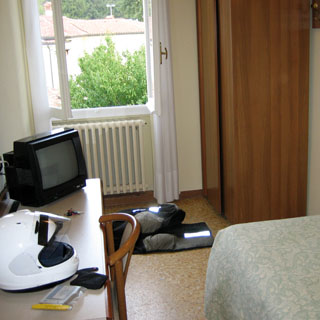
Probably the smallest room I had on the trip, but no matter. I was invited to park my motorcycle in the lower level garage, under the hotel with the cases of empty wine bottles. It seems the owner of the hotel owns a 1950's Guzzi Falcone.
See that lone tree in the worked field? I saw many such instances. Clearly, that tree is not a thousand years old, but the land may very well have been under cultivation that long, and more. So why is that tree there? Who would plant a tree in the middle of a cultivated field, and why? And yet, it was common to see.
A wider road and better marked--I am not on one of the narrow secondary roads such as I rode yesterday.
Piandelagotti for a rest break. Actually, my rest breaks were only breaks from riding. I almost always spent my off-motorcycle time walking around the towns. If there is a typical town along this highway, Piandelagotti will serve, although the road through town is wider than most (generally there is no room for parking).

Toscana
Fiumalbo is almost too picturesque.
When you build your town on the side of a hill, you have to put up with steep sidewalks.

Abetona is clearly a center for winter sports, but I was glad enough not to have to worry about snow.
I stopped near Lucchio to look at this large stone quarry. I couldn't tell you what sort of stone they were cutting, but there were very large slabs (about 6" thick) stacked in this holding area.

Scesta is nestled at the base of the mountain. And, Palleggio is just across the valley, within view.

I parked the motorcycle to get a break from the heat and rest in the shade of the old church.


Most every small village (such as Palleggio) has a community water supply--this one is next to the church. While I was there a number of people walked to the free-running water spout and filled plastic jugs.
I followed this path down from the town. Eventually it would lead to the valley floor. It's likely that this path has been in use for a very long time. Of course, now there is a paved auto road up to the town.
This bridge at Bagni Di Lucca is 500 years old. It was modified in the 19th century to allow for the railroad, which sadly took away the symmetry. I waited for the longest time for that man sitting on the edge of the bridge (in the middle) to either jump or move on, but he insisted on staying there.
Mostly I stayed away from these larger towns as joining heavy traffic through countless chaotic roundabouts isn't much fun (well, actually it can be, but it's not very relaxing). But, I did stop at Lucca.
As always, being on a motorcycle eliminated one of the real problems that tourists trapped in cars had to contend with: parking. I was always able to park very close to whatever I wanted to see, while they were often left roaming for an open space along a faraway street.
This motorcycle started out as a Guzzi Daytona, but it has been heavily modified. By the looks of it, it's been used pretty hard, too.
Lucca from the air (thanks to GoogleEarth).

It is remarkable that the original town walls are still intact and that the core is unchanged. Marking my parking place with the GPS as well as the particular passage under the wall that I used was a smart thing to do. I would have no trouble finding my way back.
The outer wall (in the aerial photograph, this section is near the lower-right corner).
I am guessing that the front of this church is Alabaster.
Did you notice that elliptical plaza in the GoogleEarth photograph? This is it.
I came across a carpentry shop devoted to repairing and making replicas of the ornate woodcarvings that were seen everywhere.

I tried to avoid it. I did everything I could to avoid it. But, I could not avoid the Autostrada out of Lucca, much as I wanted to. There was no place to turn around, and I was swept onto it with a hundred other cars.
This gentleman was running a classic shell-game at a rest stop along the Autostrada. I placed no bets.
After flying by Pisa and Livorno, the Autostrada dumped everybody out near Cecina. It's certainly the fastest way around, but a freeway (or, in this case, a tollway) is not at all what I wanted. The world looks the same, everywhere, from an 8-lane highway.
I backtracked up the coast to Vada for the night.

This town had the feel of being a destination for the local middle-class--not International tourists. That's fine.

Vada's town plaza.
And, amazingly, there was a self-serve Laundromat (a term not used) within walking distance of the hotel. Perfect. I was nearing the end of my supply.

Curiously small front-loaders (which worked fine). The detergent was supplied automatically. You only had to feed it the proper amount of metal tokens (purchased at another machine), and select from the unnecessarily large array of options (what RPM would you like for the spin cycle?). Those are my colors on the left and whites on the right.
This was my second night on the Mediterranean. I'd now be crossing over to the other side.
Volterra was my destination. Why? I wanted to stop at another old city in Tuscany, but Siena looked too big (which was also why Florence was avoided). Volterra looked just right.
This is wide-open agricultural country. It reminded me mostly of the Pallouse Hills of Washington, but that's still not a close match.
The old castle of Volterra is now used as a prison, and is not open to the public.
Once again, parking is the easiest.
Inside the city walls.

You might not think from the somewhat plain exterior that the interior would be so spectacular...
...but, it is.

Roman ruins (a theater) just outside, and against, the city walls.
As with most all of these walled cities, Volterra is built on top of an old volcanic butte.

Ah. Now I'm back on the obscure secondary roads that I like so much. No traffic at all.
Not to worry, I had full confidence that there would be no cars coming around that corner.
A Tuscan farm.
I'm not so good at identifying crops, but, I can at least identify this.
Riding across the region of Chianti.
Bibbiena seemed a good place to stop for the night. I'd ridden across the open, rolling hills of Tuscany, and would now be entering mountains, once again.

Bibbiena highlighted a key difference from many towns in the US. Most towns in Montana (to pick just a single state, which in many ways looks like this area) were founded in the late 19th century along the railroads, or, if older, along one of the trails. This means if you want to see the oldest part of a typical town in Montana, you should find the old (and probably abandoned) train depot. That's not the case with Bibbiena and other such towns. Here, the tracks are in the newer part of town. The oldest (the core) part of town will generally be up the hill and off the valley floor.
I begin to see more and more sportbikes.
The next morning, after a couple of false starts down roads that were not helpful, I rode through the Paraco Nazionale (no translation required) to Badia Prataglia.
I actually wanted to go to Serravalle (being an especially old village), but I kept missing potential turns (oh well).
I include this picture as an example of the sort of outdoor altar that was fairly common in the mountainous areas. It was off from the road, near what was likely the old foot path.
Not much traffic to worry about. When I saw the sheep coming down the road, I pulled over and shut the engine off.

Even so, you can tell that they didn't want to get too close to me. Off in the background you can see one of the dogs bringing up the rear. Those dogs were remarkable.
Bad pavement sometimes, but never so bad as to be a concern.
I parked the motorcycle on the shoulder, and walked out on this promontory that overlooks the valley.
This was sport bike heaven. Lots of people on the road with me. Most of them passing me... That's fine. Chiusi Della Verna
I did see a couple of other Guzzis, including this nice LeMans (I can't say that this crowd was much impressed with my own machine).
Stopped in Sestino for a little something to eat.
Marche
By this time I had decided to head for San Marino, and then drop down to the coast, someplace near Rimini. So, I started picking out some back roads that would get me there.
This is near Frontino and is pretty typical. Houses and farm buildings down low, and more impressive buildings and monasteries up on the ridge.
This is not far away, and required the only ride of the trip on a dirt road. The larger building on the left is the church (with remarkable wall paintings inside). To the right seemed to be a restaurant that the monks ran. In fact, there were a number of high-performance cars in the lot (notice the helpful sign for parking at the base of the tree) that probably did not belong to the monks...
Monte Cerignone. Always nice to be able to park in the town plaza.
This photograph is worth noting because San Marino is mostly identical, except on a larger scale. This sort of uplifted terrain is common.

 San Marino
San Marino
It was actually something of a chore to get into San Marino. The old town is on the top of a hill, and the road to the top is a series of zig-zags. Very tight turns in some cases.
Convenient parking, as usual.
The view from San Marino, looking east at Rimini and the Adriatic Sea. Seeing this, and seeing that the entire coastline was really an extended city, I decided that I didn't really need to ride down there.
The Most Serene Republic of San Marino. Ranks 5th in population of all countries (the inverted list). Not a member of the EU, but euros are allowed. Best I can tell tourists are the main source of income, and likely banking/tax havens of some sort is next. Curiously, because it protected the leaders of the unification movement of the 19th century, it was allowed to remain independent when all the rest of Italy was unified (I learned something reading the plaques).
For me, though, it was just a very crowded place to go shopping. Not what I was after.

Marche
I dropped down off the hill and turned inland instead of to the coast as I had been planning earlier. That's fine. I like these mountains.
This is a fork of the Marecchia River, near Ponte Messa. I parked the bike, and worked my way through the brush to walk out on the riverbed.
Casteldelci is an interesting little village well off the beaten path. I walked all of the streets, and didn't see a single person. There was a hotel, but the sign on the door said that nobody would be there until 7:00. As I didn't want to risk waiting that long (at the risk that there be no available rooms) I continued on.
It did occur to me that I hadn't gone very far since that morning (at least as the crow flies). But, I was at least careful to avoid crossing my earlier route.

Emilia-Romagna
The larger town of San Piero In Bagno seemed to be having some sort of celebrations this evening, and the few hotels I saw had cars parked everywhere. I didn't even stop to see if they had any rooms. Turning (again) towards the coast, I saw a small sign for a hotel near Sarsina. Riding out on a country road for a couple of miles, I wasn't sure what to expect.
One of the nicer hotels of the trip. During the season, this place is apparently a very busy business convention center. As it was, there were not very many people here, and I was the only one in the restaurant. Even so (or perhaps because of that), the service was very good.
Motorcycle parking at the door. The man on the right was sharpening knives.
The plan this morning was to take whatever roads would eventually get me into Imola. That wasn't much of a plan. I stopped near Spinello to figure out where I was.
Out of the valley to attack the mountains, again.
Look closely and you'll see several levels of the same road. This was one very twisting highway as it climbed up the side. Today was a drizzling and rainy day. It never quite poured (or at least, not long), but then, the mist never went away, either.
Toscana
I'm always attracted to old abandoned buildings... I couldn't quite tell what this had once been. Probably lots of different things.
Passo della Calla is not high, but it was getting chilly. Time to zip up the vents in the riding suit.
The town of Stia for a light lunch break.

The point of the picture (other than being another gas station--a popular subject with me) is to give some idea of how a number of service stations are little more than pumps at the side of the road.
I liked this little town. Notice that public water fountain...
...I'm sure there's some well known mythology behind this animal with a snake coming out of its mouth, but it did seem a disturbing way to get your water.
Emilia-Romagna
Following the Torrente Santerno into Imola. I expected the road to eventually straighten out as the mountains gave way to the foothills, but it remained a twisting thing until the mountains were gone--no foothills.

Near Londa. In the late afternoon drizzle with low clouds, this was almost a mystical area. I parked the motorcycle and walked over that bridge and towards the church.
I stopped in the center of Imola (next to the castle) in the now pouring rain and checked with a likely hotel. I was told that not only were there no vacancies, I'd be lucky to find anything at all in Imola (at least that was my translation of his Italian). No problem, just keep going.
I have learned not to look for hotels on the outskirts of towns (as would be common in the western US), but instead to ride directly into the town core. That's where I found this hotel in Lugo. I was riding in fairly steady rain by this time, so I didn't want to have to try very many places. As happened, there was an available room. This place may not look like much from the outside, but it was quite an upscale place on the inside--looking like the interior was designed by Andy Warhol.
I had a chance to walk many of Lugo's streets.

The corner tower of the castle.

I could easily guess the decade that this monument and building were built. They were not good years for architecture in Italy (or Italy, for that matter). The monument is dedicated to Francesco Baracca, an Italian aviator I had not heard of (but now know to be Italy's top ace from World War I who died in 1918). That's a stylized airplane wing, behind the statue.
Looking for relief from the rain, I came across an art exhibit by Lorenzo Mariani.
That's Lorenzo, below (and his mother, below that). Along with his paintings were several videos that he had done as a student. He is hoping to study at the London school of art.

I recognized the building (it's the same as in the photograph, above), and I presume that the aviator in the painting is the same as in the memorial statue. The rest, I'm not sure about. Likely it all means something if you're from the area.
Within the Po Delta is the Abbazia Di Pomposa. This Abbey has been here well over one thousand years.
As with most, not all of the buildings were that old, and I'd guess that it would be difficult to sort out when each structure was built and rebuilt.
These next two photographs were taken for a reason. All the time that I rode in the Po River Valley (a name I use, but I'm not sure if there's a more official name) I would see abandoned large factory buildings along with quite new factories. I recognized many common names with some of them. This is an industrial area along with the more obvious agriculture.
This is your classic abandoned factory building. I have no idea what was once made here.
And, this is typical of something much newer. I would guess that Valfrutta is some sort of food processing company.
One of my goals for the day was to ride to the end of the River Po. I had no idea what might be there, but I figured that it ought to be interesting.
This is near one of the outlets of the river. Like the Mississippi, the Po empties into a large delta through several forks.
'
All of this has been reclaimed from what must have been very swampy land at one time.
A curious place. In the foreground is the Po. But, beyond those break rocks is the Adriatic Sea. At the point, the river is flowing very fast, and very deep.
Best to hope that the levee never breaks, else this is all under water.
Wooden platforms and buildings of this sort extended well out into the shallow bay. What they're fishing for is unclear. Eels?
I guess these are not popular roads for the sport bike crowd...
Veneto
I did not want to go to Venice and I did not want to go to Padova. But, I had to get beyond these large cities, and that took some doing. I had hoped to avoid all the congestion that would come from these areas, but I guess that wasn't possible.
I was just starting to wonder if I'd find a hotel before the sun went down, when I entered Castelfranco and saw the Albergo Roma across the street from the old walled town.

This street is within the city walls. A city gate is at the far end, under the clock tower.
I was done with the plains, and done with the Appennino Mountains. Today I'd be riding into the Dolomiti. My first goal was Feltre, but after that I'd just see what looked likely. One thing I needed to pay attention to was how far I could expect to ride in these mountains so that I didn't wander too far in the wrong direction. I was at the point in the trip where I needed to make sure that my final arrival time at Lake Como could be done without any rush.

Frazione Santa Maria. I was not expecting such rugged, bare mountains.
Mountain pass after mountain pass. You really felt like you'd accomplished something after reaching the top.
Just stunning. I was reminded more of the Canadian Rockies than anything I've seen in the US.
I would have had something to eat in Predazzo, but it seemed that I was there during the wrong hour, and the whole town was closed for business.
The flowers on the balcony? Very common in all the small towns.
As you might expect, there were plenty of tunnels, but thankfully, none that were over a mile long. It's hard to see the mountains when you're in a hole in the ground.
You can easily see my road, across the valley.
The steel towers support the chairlift cables for the ski runs. This was a fun road.
At the time, I thought that these were somewhat sharp turns (particularly the inside lane). I would eventually find that these were nothing. Nothing at all.
There's one of the dreaded tour busses entering the snow shed. In the turns, they take up both lanes.
I loved riding in this area. This was one of my best days.
It is hard to capture just how tall these mountains appeared from the level of the highway. And then, to think that the road would eventually have to climb out of the valley over one of the narrow passes.
Is there a more spectacular site for a town? This is Cortina D'Ampezzo. My hotel was not far from that church steeple (under wraps for restoration work).

My room is on the third floor.
This problem is hardly worth the showing, but as it's the only thing that remotely went wrong, here it is.
The key for the saddlebags just broke into two pieces (it must have been nearly in two pieces from the start). This was not good news since I didn't have a spare, and since all my clothes were in these saddlebags. I looked for a painless way to disconnect the latches without damaging them, but they're pretty secure.

The local locksmith (a story in itself) was not able to make a match from the remnant of the key, so I took a different approach. With a pair of needle nose pliers (bought at the same hardware store) I was able to drop the broken piece of the key into the lock and unlock the latch. Then I'd carefully retrieve the bit, and open up the other locks. This actually worked. So the latches still worked; I just couldn't lock them anymore.
The view from my window.
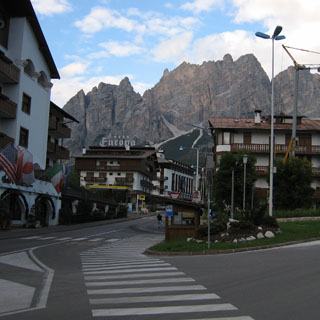
I took this picture to serve as an example of what a breakfast at the hotels was like. Some had more, and some had less. Breads, coffee, fruit juice, and a wide variety of packaged food. Don't look for the killer breakfasts that you see in England.
Trentino-Alto Adige
Running north out of Cortina, I dropped through the mountain passes to a wide, lush valley. This shot is looking south through one of the passes that I had just come through.
This will serve as being almost typical of the alpine villages that are common throughout the region. I parked the motorcycle off the side of the road, stepped over a fence, and walked across this green field.
And no, I didn't break into singing from "The Sound of Music."
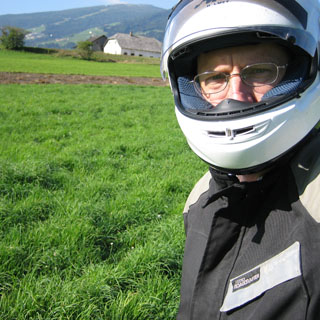
Castle near Elzenbaum. This is very near the Austrian border.
Jaufenpaβ Pass. Turn right, and you're in Austria.
Unbelievably spectacular riding. You wouldn't think that a road would even be here. I suppose that the roads follow (more or less) the old foot paths that have been used for centuries.
Near Passo Giovo. I had no doubt that these gentlemen had enjoyed a few beers that day.
It was interesting that while the apples in the orchard were only the green variety, the trees at the end of each row had only red apples.
Passo dello Stelvio (9,050 feet) is one of the most famous passes in the Alps (and is the second highest), and as I was close enough, I had to ride it. I'd seen pictures like this, before, but this still does not prepare you for that first look up the valley. Remember that the picture shows only the final few turns before the summit. There are actually close to fifty turns on each side of the pass. So, after you think you've been riding some pretty serious stuff, and you make that big right turn and you have your first look, and you see the road zig-zagging up the seemingly vertical cliff, it gives you pause...
I was glad that traffic was very light. I had no traffic in front of me, and I had nobody trying to pass me from behind. Those sharp right hand climbing turns with the handlebars at full lock and your left hand ready to feather the clutch if the engine started to lug... All I can say is that I never had to put a foot down, but I'm not going to say that I wasn't ready.
I bought a bratwurst sandwich from this fellow. Pretty good.

I watched some of these guys coming up the hill. I would not do what they do. To attack a road like this at speed is just nuts. There is no runoff, and no margin for anything to go wrong. Needless to say, most of the traffic was by motorcycles. I didn't see many cars.
The road down the south side was also challenging, but compared to the north side, this was hardly worth a mention. In any case, it is far easier to go down the hill than up. Going down, you don't need to worry about lugging and stalling the engine--as long as you're moving it will be happy.
The view looking back to the north (within feet of the Swiss border).
Lombardia
I stopped at Bormio for the night. By now, I knew to skip over the lower cost hotels and go right for the top. In the off-season, the prices are really not much different. This place was nice. In the late evening, I relaxed with a glass of grappa and a book in one of the very comfortable lounges on the ground level.
The old section of Bormio (I saw these two women, and knew I had to have this photograph--luckily they didn't see me stalking them from behind).
The old bridge over the river.
Across the bridge is a very old part of the town--no shopping here.
One of the lower doors was open a crack, so I just went in. The light is from my flash--it was actually very dark (and damp). The rooms are upstairs, storage (and animals?) is on the ground level.
The view of Bormio looking back up towards the mountains (and Switzerland).
Something seemed to be happening in Tirano, so I parked the motorcycle and walked back to see. It turned out to be the 500th (plus a couple) anniversary of the town.

I stayed for part of the opening prayers and talks, but it looked like whatever they were planning was going to take quite a long time; so I left.
I'm now back riding the same highway that I started out on, eleven days earlier. But, this time, the same scenes didn't seem so unusual. Somehow, a fortified castle on the top of a mountain, or vineyards on an impossibly steep hillside, or a highway that threaded through the center of a town with barely enough room for two cars to pass seemed entirely natural.
Return to Mandello del Lario.
I arrived in the afternoon, which gave me plenty of time to take care of business at Agostini and to carry my bags down to Mamma Ciccia.
After doing nothing more exciting than sitting on the shore of Lake Como reading a book (life should be so tough), I had a terrific dinner that night at the ristorante, and was still in no rush to pack things up the next morning. Silvia was able to do my laundry (thanks, again!), so I was in good shape to finish out the trip with clean clothes.
I knew the routine to get back to Milan.
This would be my last full day in Milan and in Italy.
I walked back to the Duomo Plaza and over to the La Scala opera house for at least a picture. Tours were available, but I've always preferred to explore on my own.
And, this time, the great crowds were not in the cathedral. What a stunning place. I've been in some large cathedrals in England, but none of those had painted interiors and so many hanging tapestries as this one.
It is hard to realize just how large and overwhelming this building is.

A last view of the streets of Milan.
And then back to Malpensa, Newark, Houston, and Kansas.
Last Words
It all went to plan. Or at least, if I had had a plan, this is what I would have wanted it to be.
Very special thanks to Alis at Agostini Moto Guzzi. Without her, I would not have even considered making this trip. I cannot think that renting only Moto Guzzi motorcycles is a big money making operation (although I hope it is), so it's especially great that Guzzi people (like Alis) do what they do for the love of it.
Signs
The first thing to know is that you should never expect to have road signs to help you on your route. If you see a sign, well, that's a bonus.
Often at intersections you'll see a number of signs posted showing the names of towns that you might eventually come to if you go that way. Note, too, that the arrows can only point left or right. There are no nuances, here. Sometimes this can be a problem. Often the listing of towns changes from intersection to intersection, so you might want to memorize several of them in order to keep on the right path.
Highway numbers may be found on maps, but you should not expect to ever see them posted on a road. If you do, that's great! More typical, though, is the mile-marker sign that will sometimes have the highway number shown in small print (as shown below). But, it is a rare intersection that will post which road you should take to follow a given highway number. The signs below? you can't tell in this photograph, but the two blue signs on the left, repeat two of the same towns as on the signs on the right--and, they point in a different direction. My recommendation is that you pack a GPS.

Cats and Dogs





Doors
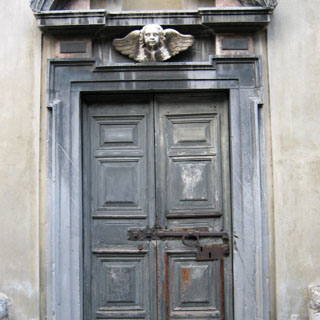

Floors
Wildflowers
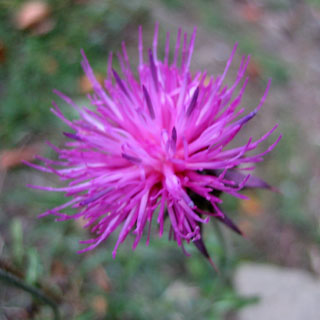

Food





Laundry
Last and Final Words
- The hotel in Milan worked perfectly. I would do it again. You could take a train directly from Malpensa to Mandello del Lario, but it's nice to have the day in Milan to catch up with the time shift.
- There are other hotels and B&Bs in Mandello del Lario, but I don't know how you could improve on Mamma Ciccia.
- I was fully planning on going to the Science and Technology museum in Milan. I just forgot about it until it was too late.
- The plastic laminated Berndtson & Berndtson map of Italy (1:800,000) was all I used. I wouldn't take any other regional map.
- GPS is almost mandatory. Of course you don't need it, but it is such a useful tool to sort out unmarked intersections that it will save you no end of trouble. I never used mine to follow a route--just to answer the questions.
- Speaking only a few words of Italian and understanding a few more was enough. Of course, the more you know, the better. But, it's amazing what you can get across with only a few words and lots of arm waving. Written Italian is not hard to figure out, so road signs and the more basic information signs were not a problem.
- I would consider using the Autostrada to quickly ride to where I wanted to be, and then not get back on until I was ready to come back.














